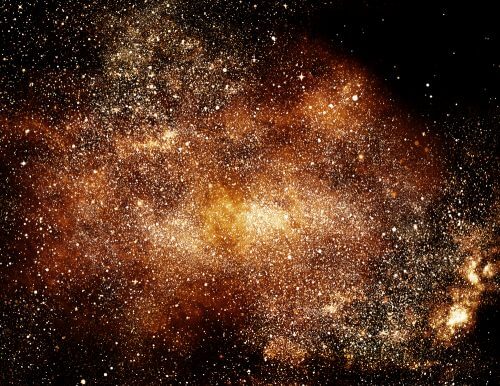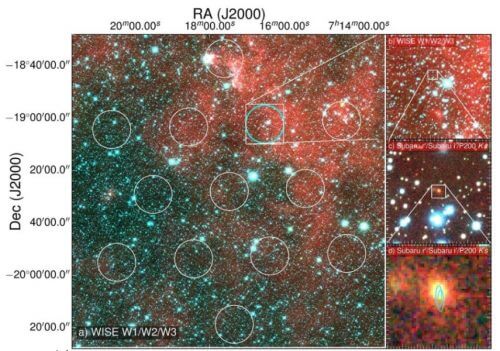FRBs are bright, mysterious radio waves that typically last only a few milliseconds. Their origin is still unknown. Despite a long list of potential phenomena that may cause them, FRBs are very difficult to detect. Before this discovery, only 16 such eruptions had been detected - all in retrospect, this is the first time such an event was caught in real time


An international research team including scientists from the Max Planck Institute for Radio Astronomy in Bonn, Germany, used a combination of radio telescopes and optical telescopes to identify the exact location of a fast radio burst (FRB) in a distant galaxy, allowing them to reassess the material content of the universe.
Their study published on Thursday, 25/2/16 in the journal Nature confirms theoretical cosmological models of the distribution of matter in the universe.
On April 18, 2015, a fast radio burst, or FRB, was detected by the Commonwealth Scientific and Industrial Research Organization's (CSIRO) 64-meter Parkes Radio Telescope in Australia as part of a survey of pulsars and radio bursts outside our galaxy. The researchers broadcast an international alert and within hours several telescopes around the world were activated to search for the signal, including CSIRO's Australian Compact Telescope Array (ATCA) and the Effelsberg radio telescope in Germany.
FRBs are bright, mysterious radio waves that typically last only a few milliseconds. Their origin is still unknown. Despite a long list of potential phenomena that may cause them, FRBs are very difficult to detect. Before this discovery, only 16 such eruptions had been detected.
"In the past, FRBs were detected by filtering data months or even years later. By then it was already too late to make follow-up observations.” says Evan Keane, a scientist at the Square Kilometer Array organization and the study's lead scientist. To remedy this, team members developed their own observing system to detect FRBs within seconds, and immediately alert other telescopes, while there is still time to look for additional evidence following the initial flash.
Thanks to ATCA's six 22-meter diameter dishes and their combined resolution, the team was able to locate the signal with much greater precision than was previously possible. And so they were able to detect radio signals that lasted about 6 days before fading. These waves allowed them to locate the location of the FRB 1000 times more accurately than in previous events.
The puzzle is still not complete and the team used the 8.2 meter diameter Subro Optical Telescope of the National Observatory of Japan located in Hawaii to identify where the signal came from. They identified that the source of the signal is in an elliptical galaxy about 6 billion light years away from us. "This is the first time we have been able to identify a galaxy where an FRB has occurred," adds Evan Keane. The optical observation also gave them the measurement of the redshift (the speed at which the galaxy is moving away from us due to the accelerated expansion of the universe), and thus the distance of an event was determined for the first time. FRB
However, to understand the physics of such events it is important to know basic characteristics such as the exact location, the distance of the source and whether the eruption will repeat itself. "Our analysis leads us to the conclusion that this new radio burst is not cyclical but arises from a catastrophic event in that distant galaxy," states Michael Kramer from the Max Planck Institute for Radio Astronomy who analyzed the radio structure of the event profile. Max Planck's Effelsberg radio telescope was also used for follow-up and post-alert observations.
FRBs show frequency-dependent dispersion, so the delay of the radio signal is caused by the amount of material it passed through before reaching us. “Until now, the dispersion index is all we had. Now that we also have a distance measurement, we can estimate the density of matter between the starting point and the Earth, and compare this with the current model of the distribution of matter in the universe," explains Simon Johnston, one of the authors of the study, and an astronomer in the Department of Astronomy and Space Sciences of CSIRO. "This allows us to "consider" the universe, or at least the normal matter it contains."
In the current model, scientists estimate that the universe consists of 70% dark energy, 25% dark matter and 5% "normal" matter that makes up everything we see. However, through observations of stars, galaxies and hydrogen clouds, astronomers have been able to detect only about half of the normal matter. The rest of the material cannot be directly observed and is therefore referred to as "missing material".
"The good news is that thanks to our observations and changes we made in the model, we found the missing material" explains Owen Keen. "This is the first time a fast radio burst has been used to make a cosmological measurement."
"This shows the potential of the FRBs as new tools in cosmology," concludes Michael Kramer, who also worked on the calculation of the weight of the missing matter. "One can only imagine what we could know if we discovered a hundred such eruptions."
Looking ahead, the planned square km array, with its extreme sensitivity in resolution and wide field of view is expected to be able to detect more FRBs and locate their host galaxies. A much larger sample will allow precise measurements of cosmological parameters such as the distribution of matter in the universe, and may provide a better understanding of dark energy.
to the notice of the researchers
More of the topic in Hayadan:

5 תגובות
"FRBs are bright, mysterious radio waves that typically last only a few milliseconds."
There is no hiding, nothing mysterious
what's not There is no receiving device
As the desires are expanded and deepened, the darkness becomes clear.
Nothing outside will change except that we will change.
(Yes, I know it's an object of ridicule, but just as we place the main importance of our importance on the studied object that is outside of us, future studies that will focus on the changes within us, they and precisely they will be the more advanced and fascinating).
Why does it take so long for comments on this site to go live? It's just frustrating.
to Mr. "maybe"
You misunderstood. There is no connection between the "missing matter" and the "dark matter".
The missing material - refers to normal material, which according to the calculations should have been larger. So where is it? I have many questions about this, but in any case - it is implied from the article.
may be…
Seriously, did you read the article?
mozar,
Did the radio bursts reveal the dark matter?